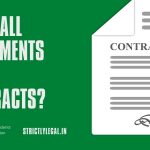Table of Contents
Introduction
Imagine sharing your innovative business idea with a potential investor, only to see a competitor launch the exact same product six months later. This nightmare scenario is precisely why non-disclosure agreements (NDAs) have become indispensable in today’s competitive business landscape. Whether you’re a startup founder protecting trade secrets, an employer safeguarding proprietary information, or a professional entering a strategic partnership, understanding how to draft a non-disclosure agreement is crucial for protecting your confidential information.
A non-disclosure agreement, also known as a confidentiality agreement, is a legally binding contract that creates a confidential relationship between parties who wish to share sensitive information while restricting its disclosure to third parties. Under Indian law, NDAs are governed primarily by the Indian Contract Act, 1872, and courts have consistently upheld their validity when properly drafted. This comprehensive guide will walk you through every essential element of drafting an effective NDA that protects your interests while remaining enforceable under Indian jurisprudence.
The Non-Disclosure Agreement is called by various names such as Secrecy Agreement, Non-Confidentiality Agreement, Confidential Disclosure Agreement, and Proprietary Disclosure Agreement.
Understanding Non-Disclosure Agreements Under Indian Law
A non-disclosure agreement is a specialized contract designed to protect confidential and proprietary information from unauthorized disclosure. Under Section 27 of the Indian Contract Act, 1872, while agreements in restraint of trade are generally void, courts have recognized that properly drafted NDAs with reasonable restrictions are valid and enforceable.
The Supreme Court in Niranjan Shankar Golikari v. Century Spinning & Manufacturing Co. Ltd. (AIR 1967 SC 1098) established important principles regarding post-employment restraints and confidentiality obligations. The Court held that while absolute restraints on trade are void, negative covenants protecting legitimate business interests such as trade secrets and confidential information are enforceable if reasonable in scope and duration.
Types of Non-Disclosure Agreements
Unilateral NDAs bind only one party (the recipient) to maintain confidentiality, commonly used in employer-employee relationships and vendor engagements. Bilateral NDAs bind both parties to confidentiality obligations, typically used in business partnerships and mergers where both parties exchange confidential information. Multilateral NDAs involving three or more parties are useful in complex transactions.
Understanding when all agreements are contracts is fundamental before drafting any legal document, including NDAs, as it helps ensure your agreement meets the essential requirements of a valid contract under Indian law.
Essential Elements of a Valid Non-Disclosure Agreement
Definition of Confidential Information
The cornerstone of any NDA is a clear definition of “confidential information” covering technical information (trade secrets, formulas, processes, designs, software code, algorithms), business information (customer lists, pricing strategies, marketing plans, financial data), and all formats (oral, written, electronic, observed).
The Delhi High Court in Shri Satpal Bakshi v. Dharm Pal Jain & Ors. (2007) emphasized that vague or overly broad definitions may render agreements unenforceable.
Exclusions from Confidential Information
Standard exclusions include information already public, independently developed, known before disclosure, received from third parties without breach obligations, or required by law to be disclosed.
Obligations of the Receiving Party
NDAs must specify use restrictions (information only for stated purpose), non-disclosure requirements (prohibit third-party disclosure, require reasonable care), and access limitations (only to those with legitimate need-to-know).
Duration and Term
Duration must be reasonable: 2-3 years for general business information, 5+ years for trade secrets. Survival clauses should clarify which obligations continue after termination. In Desiccant Rotors International Pvt. Ltd. v. Bappaditya Sarkar (2014), Delhi High Court upheld five-year post-employment confidentiality as reasonable.
Consequences of Breach
Understanding various modes of discharge of contract helps structure breach provisions. Key remedies: injunctive relief (Section 41, Specific Relief Act, 1963), monetary damages (Section 74, Indian Contract Act treats liquidated damages as compensation ceilings), and mandatory return of information.
What kind of Information is protected with NDA?
The information protected in NDA (Non-Disclosure Agreement ) can be broadly ranged from manufacturing process strategy, sale plans, potential customers, marketing strategy, or software designs.
- Customer Information This may include contact information, communication record, or even customer preference of major customers.
- Financial information- This may include the cost accounting information, balance sheet, and account of assets and liabilities.
- Intellectual property -This may include all kinds of intellectual property held by the company, be it software, patents, copyrights, or trade secrets.
- Marketing Strategies or Information – This may include advertising techniques, pricing strategies, and billing policies.
- Operation Information – This will include internal information about the company’s operation. Employee data, payroll information, director’s posts, internal costing, supplier information, etc.
Types of Non-Disclosure Agreements
- Mutual Agreement – When two parties are partnering or going into any transaction or agreement, each of the parties may reveal such information which would aid the common objective. In such an event both parties agree on not disclosing the secretive information.
- Non-Mutual Agreement – Where only one party receives the information thus it is a unilateral or one-sided prohibition from disclosing information.
- Merger and Acquisition (M&A) – There are a lot of changes that take place when companies consider going in for private or public M&A. It has been usually seen that it begins with signing an NDA as these will convey to the new parties to restrict one or the other parties from disclosing confidential information.
- Employer-Employee – Once employees are hired then they often are told to execute an NDA, which restricts the employee to disseminate company-owned information from time to time.
The exception to Non-Disclosure Agreement
The Disclosure Agreement – This is an exception to the genre of Non-Disclosure Agreement (NDA). There might be unavoidable or necessary situations such as any administrative body or government authority can demand to share of sensitive/ confidential information. Thus, those cases would fall under the exception category of Non-Disclosure Agreement because such disclosure would not amount to a breach of the agreement.
Elements of Non-Disclosure Agreement
- Participants in the Agreement
Firstly the parties or participants of every non-disclosure agreement must be specifically designated. The participants in the agreement can be individuals, employees, representatives of the company, a company, etc. A company should clearly define itself, the legal structure and ownership, etc.
- Definition of Confidential Information
The second most crucial clause would be defining the NDA, and what information would be considered to be confidential. It cannot be based on assumption, expectation, or generalization. It should be the company’s duty to clearly draw the lines around the information which are not meant to be shared. The party disseminating the information will have a broader definition because they are the ones benefiting the most from the agreement while the party receiving the information will have a narrow definition under this clause.
- Exclusions of Confidentiality
This clause can be handy when the instant case would require to state/define the information which is not to be meant confidential. This makes things less complicated because the party/parties will have specific information which they can share or disclose. One of the advantages of this type of agreement is that the company will cover up the majority of its sensitive information and there will be fewer chances of it losing out on any essentials.
- Appropriate Uses of Information
At times the information may be open and totally confidential but it may simply specify ways in which external parties may use it. For example, it may allow disclosing the operation process to another party, however with certain limitations such as the information cannot be shared with a competitor or benefit of personal finance.
- Time Period
As much as early these agreements should be made, the agreement should also cover the time period within which the secrecy needs to be extended. Depending on the nature of the transaction the time period is decided, and it can extend from 1 year to 10 years.
- Parties to Disclosure-
A non-disclosure agreement should also define with whom the party can share confidential information. For example, it can share confidential information with associated representatives, partners or companies.
- How to Return the Confidential Information
It is important to specify in which way the received information by the receipt should be returned, for example, either by returning the document itself or destroying the whole information received by the recipient.
- Other/Miscellaneous Provisions
Along with the above essentials, NDAs are open to customization. Different areas of business would have different requirements, agencies, and priorities which it may keep sensitive.
Step-by-Step Guide to Drafting an NDA
Step 1: Identify Parties and Purpose
Clearly identify all parties with complete legal names, addresses, and registration details. State the purpose for sharing confidential information.
Step 2: Define Confidential Information Comprehensively
Use the formula: broad coverage + specific examples + format inclusion. Example: “‘Confidential Information’ means all technical, business, and financial information including trade secrets, know-how, customer information, pricing strategies, software, and proprietary information disclosed orally, in writing, electronically, or by observation, whether or not marked confidential.”
Step 3: Specify Exclusions
List standard exclusions after defining confidential information to demonstrate reasonableness.
Step 4: Detail Obligations
Draft clear obligations using precise language. Consult basics of contract drafting for beginners for proper legal language.
Step 5: Include Standard Clauses
Include governing law (specify Indian law and jurisdiction), severability (invalid provisions don’t invalidate entire agreement), entire agreement clause, and written amendment requirements.
Step 6: Draft Termination Provisions
Distinguish between disclosure period termination and confidentiality obligations (which survive). Example: “Agreement continues two years unless terminated with thirty days’ notice. Confidentiality obligations survive five years from each disclosure date.”
Common Mistakes to Avoid When Drafting NDAs
Overly Broad Definitions: Avoid vague terms like “any and all information.” Courts require certainty of terms and may refuse enforcement.
Unreasonable Duration: Perpetual confidentiality for ordinary information or excessive periods invite judicial scrutiny (Percept D’Mark v. Zaheer Khan, 2006).
Ignoring Mandatory Disclosures: Include exceptions for legally required disclosures with reasonable notice provisions.
Inadequate Consideration: Ensure clear consideration exists, especially in unilateral NDAs.
No Return/Destruction Provisions: Include requirements for returning documents and deleting electronic files.
Vague Jurisdiction: Be specific: “Courts at New Delhi shall have exclusive jurisdiction” not “appropriate courts.”
Ignoring Third-Party Needs: Permit disclosures to advisors/contractors while requiring similar confidentiality agreements.
Understanding contract of indemnity and guarantee concepts helps draft additional security provisions.
Enforcing Non-Disclosure Agreements in India
Indian courts provide multiple breach remedies:
Injunctions: Under Section 41, Specific Relief Act, 1963, courts grant injunctions preventing threatened breaches or continued violations.
Damages: Under Section 73, Indian Contract Act, parties recover damages considering information’s commercial value, competitive advantage lost, and development costs.
Account of Profits: Courts may order breaching parties to disgorge profits from unauthorized use.
Enforcement Challenges
Proof Requirements: Maintain disclosure logs, delivery receipts, and written confirmations to establish information was disclosed under the NDA.
Proving Breach: Use digital forensics, witness testimony, and circumstantial evidence.
Damage Quantification: Consider liquidated damages clauses within Section 74 limits.
Cross-Border Issues: Consider arbitration clauses with institutional arbitration in India for international parties.
Key Takeaways
- Clear Definitions Are Critical: Define “confidential information” with specific categories and examples while including reasonable exclusions to ensure enforceability under Indian law.
- Reasonable Duration Matters: Limit confidentiality periods to what is reasonable for your industry and the nature of information—typically 2-5 years for business information, potentially longer for trade secrets.
- Specify All Obligations Explicitly: Detail how the receiving party must protect, use, and handle confidential information, including security measures and access restrictions.
- Include Proper Remedies: Clearly state available remedies including injunctive relief, damages, and return of information to strengthen enforcement options.
- Balance Protection with Practicality: Overly restrictive NDAs may be unenforceable; balance protection of legitimate interests with reasonable business practices and industry standards.
- Document Everything: Maintain detailed records of what information was disclosed, when, and to whom—this documentation becomes crucial evidence if disputes arise.
Frequently Asked Questions
What is the difference between an NDA and a confidentiality agreement?
No legal difference exists—terms are used interchangeably. Both create binding obligations protecting sensitive information. “NDA” is more common in business while “confidentiality agreement” is sometimes preferred in employment contexts.
How long should an NDA last in India?
Duration depends on information nature and industry. Courts typically uphold 2-5 years for business information. Trade secrets may justify longer periods. Perpetual confidentiality for true trade secrets is sometimes enforceable but carefully scrutinized for reasonableness.
Can an employer enforce an NDA after an employee leaves?
Yes, with reasonable terms. Restrictions must be proportionate in scope and duration. Courts apply Niranjan Shankar Golikari principles requiring post-employment restraints protect legitimate interests without unreasonably restricting livelihood. Typically, 2-3 years post-employment is upheld.
What happens if someone violates an NDA in India?
Violation constitutes contract breach under Indian Contract Act, 1872. Remedies include injunctive relief preventing disclosure, damages for financial losses, and mandatory return of confidential materials. Trade secret cases may allow criminal remedies.
Do I need a lawyer to draft an NDA?
Legal consultation is advisable for important agreements. Lawyers tailor NDAs to specific situations, ensure compliance, include appropriate protections, and maximize enforceability. For high-stakes situations with valuable IP or sensitive information, professional advice is essential.
Are NDAs enforceable for verbal information?
Yes, but proving verbal disclosures is challenging. Well-drafted NDAs explicitly cover oral disclosures. Strengthen enforceability by following up orally shared information with written confirmations, creating enforceable paper trails.
Can an NDA restrict general skills and knowledge?
No. Courts distinguish between proprietary information (NDA-protectable) and general skills/knowledge acquired during relationships (non-restrictible). Section 27 voids trade restraint agreements, protecting workers’ professional capability rights. Define confidential information carefully to avoid restricting general knowledge.
What if I receive confidential information without an NDA?
You may have implied obligations even without formal NDAs if information is marked confidential or circumstances imply confidentiality. Supreme Court in Anil Gupta v. Star India Pvt. Ltd. recognized duties arising from relationship nature. Best practice: immediately discuss executing formal NDAs to clarify obligations.
Conclusion
Drafting an effective non-disclosure agreement requires balancing comprehensive protection with practical enforceability. By clearly defining confidential information, specifying reasonable obligations and durations, and including appropriate remedies, you create a powerful legal tool for protecting your valuable business assets. Remember that the best NDA is one that is clear, fair, and tailored to your specific needs while respecting the principles established by Indian courts.
Whether you’re protecting trade secrets, facilitating business negotiations, or securing employment relationships, a well-drafted NDA serves as both a shield against unauthorized disclosure and a framework for professional confidentiality. Take the time to draft your agreements carefully, seek legal counsel when needed, and maintain proper documentation of your confidential disclosures to ensure maximum protection under Indian law.
I am law student and a freelance content writer who loves to write about anything and everything.




